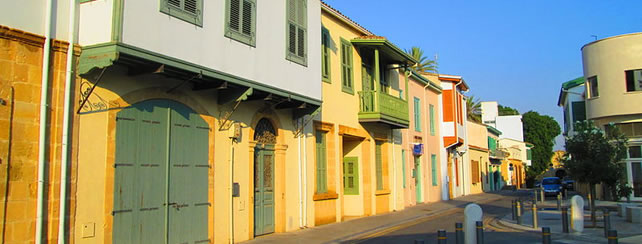
Nicosia lies roughly at the center of the island, with a rich history that can be traced back to the Bronze Age. It only became Capital of the island in the 11th century AD. The Lousignians turned it into a magnificent city with a Royal Palace and over fifty churches.
Today it blends its historic past brilliantly with the bustle of a modern city. The heart of the city, enclosed by 16th century Venetian walls, is dotted with museums, ancient churches and medieval buildings preserving the nostalgic atmosphere of years past. Yet this old heart is split in two, leaving Nicosia the only capital city in the world to remain divided by force. The new Nicosia developed outside the walls became a contemporary, business and cultural center. Just a few miles away areenchanting places of interest such as Byzantine churches and monasteries, archaeological sites and charming villages. Without a doubt, Nicosia the 1000-year-old capital of Cyprus should be on every visitor’s agenda. It lies roughly in the center of the island; within easy reach of the other towns and a day in Nicosia will be a day well spent.
The old walled city of Nicosia is unique and definitely the place to head for first. Encircled by strong fortress walls built by the Venetians in the 16th century, the enchanting old city is scattered with buildings and monuments of historical interest as well as little shops, cafés and tavernas. The Nicosia Jewels Museum and the Municipal Arts Center are both well worth a visit. The ‘Levention’ Municipal Museum, with an imaginative presentation of the capital’s history, was awarded the title “1991 European Museum of the Year”. To walk through the old city is to step backwards in time. Narrow streets and old houses with ornate balconies jut from weather beaten sandstone walls, smell of jasmine flowers in those long summer evenings, and craftsmen in small workshops practice trades unchanged for centuries. ‘Laiki Yitonia’ – Folk Neighborhood – is a pedestrian section, which has been carefully renovated to evoke the atmosphere of past days. The two main streets of old Nicosia, Ledra and Onasagorou, are lined with shops of every type, and both streets are pedestrian – only. Not to be missed is the unique Cyprus Museum, housing island’s most important collection of Cypriot antiquities and treasures from the Neolithic Age to the Roman Period. In contrast to these ancient finds is the State Collection of Contemporary Art, and on the other side of town, just off the main Limassol road, is the Cyprus Handicraft Center. Another award winner is the city’s renovated ‘Pyli Ammochostou’ – Famagusta Gate – one of the original entrances to the old city, which won the Europa Nostra award for its restoration. Many old churches are to be found in this part of town, and other places of interest are the Folk Art and Byzantine Museums, the Archbish’s palace, the Cathedral of Ayios Ioannis with its beautiful frescoes, the National Struggle Museum and the intriguing house of Hadjigeorgakis Kornesios – a fine example of l8th century architecture – which houses the Ethnological Museum.
Source: www.world66.com
Sponsored by: Nicosia Hotel



